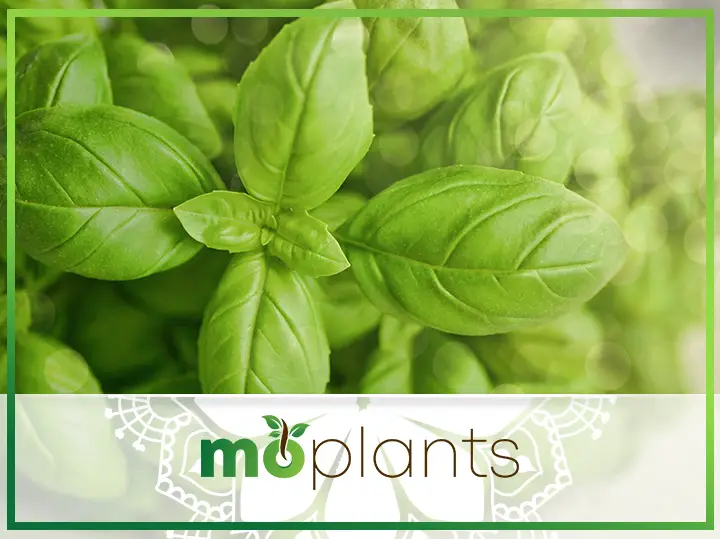Are you looking to add a delicious and aromatic herb to your kitchen garden? If you are fond of homemade pizza and fresh Caprese salad, you will simply love having easy access to a delightful basil plant growing right at your windowsill.
More commonly referred to as sweet basil, it is a hardy herb that grows well indoors and outdoors. Although basil is considered a staple in Italian cuisine and enjoys popularity in all parts of the United States, it is actually native to Southeast Asia and Central Africa.
The fragrant leaves of this charming plant carry a rich flavor that can add a touch of freshness to any food. Some varieties of basil are known for their licorice and cinnamon-like taste, while others are spicier and zestier.
Basil requires warm weather to thrive, making it an ideal plant for those living in USDA hardiness zones 10 and 11. However, if you live elsewhere, you can still grow this herb indoors and continue to harvest its sweet-smelling leaves for an entire year – or even longer.
If you prefer to garnish your food with organic herbs or enjoy the decadence of fresh pesto, this guide on how to grow and care for the basil plant is meant just for you.
Introduction: Basil
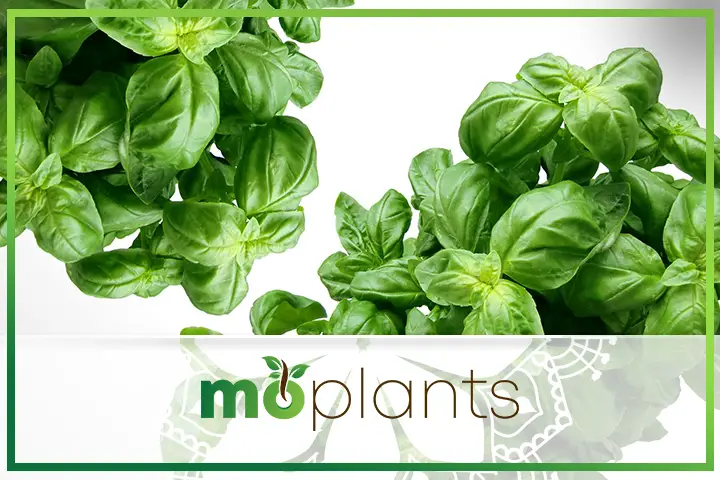
The botanical name of basil is Ocimum basilicum, and it is a member of the mint family along with thyme, rosemary, and sage. While the leaves of this plant are widely used in multiple cuisines in different parts of the world, basil seeds are considered a popular ingredient in Thai dishes.
Like most other members of its family, basil is a low-maintenance plant that adapts quickly to its environment and grows without any hassle. Since it is mostly grown as an annual, basil is a favorite among beginners as it doesn’t require extra care or attention.
The sweet basil leaves are usually green in color and boast a rounded cup-like shape. However, other types of basil feature a variety of hues ranging from green to purple. Some of these herbs have crinkled leaves, while others may have smooth foliage. In addition, these plants may also produce tiny white or magenta flowers that can attract bees to your garden. These buds may not look much, but they are perfectly edible and can add a pop of color to your salad.
Moreover, basil is a fast grower. You can ideally harvest the leaves within four weeks of planting seeds in the container. Furthermore, a mature plant can reach the height of 18 to 24 inches, making it an excellent plant to grow in raised beds or small containers on your terrace, window sill, or kitchen counter.
Apart from being aromatic and flavorsome, basil is also a great source of Vitamin A, Vitamin B6, Vitamin C, Vitamin K, iron, manganese, and magnesium. People have also been using it for centuries as a medicine to treat stomachache, loss of appetite, kidney problems, fluid retention, warts, infections, and insect bites. In addition, basils plants can deter mosquitoes.
You can also use the plant leaves to make sweet-smelling basil oil.
How to Grow Basil

While it is not difficult to grow, basil still requires certain conditions to flourish and produce healthy leaves. Here are some tips that may help you expand your herb garden with beautiful basil plants.
Planting and Placement
Basil is extremely sensitive to cold and frost. So, if you are planning to grow this herb, make sure to sow the seed or transplant the plant in the spring or summer months.
Indoors, these plants can easily last through harsh winter months, provided the temperature inside the house doesn’t drop significantly. However, if you are planning to grow basil outdoors, make sure to cover the plants with garden fabric to increase their lifespan.
Moreover, most experts suggest placing basil near south and southwest windows.
Temperature and Humidity
Native to warm regions, basil appreciates temperatures between 50 and 80 degrees Fahrenheit. If exposed to cold weather or temperatures below 50 degrees Fahrenheit, the plant can turn black and eventually die.
Frost is one of the biggest enemies of your basil plant, so make sure to protect the tender herb from harsh conditions during the winter months.
Furthermore, basil prefers humidity levels between 40% and 60%. Hence, unless you live in a very dry climate, you won’t likely have to invest in a humidifier to keep your basil plant fresh and healthy.
Exposure to Sunlight
This nutritious and flavorful herb needs about six to eight hours of sunlight for proper growth. However, it does well in partial shade too. Ideally, it would help if you moved your basil plant to a location that receives morning sun and afternoon shade.
Please note that exposure to direct sun for extended hours can scorch the leaves of your beloved herb.
Watering Frequency
Adding about one inch of water to your basil each week is more than sufficient for its growth. Plants that grow in pots usually require more moisture than those grown outdoors in the ground. Nevertheless, you should consider touching the top inch of soil to check if the plant needs hydration. Otherwise, you may end up overwatering the basil, ultimately killing it.
Moreover, the best time to water the herb is early morning. As long as you keep the soil moist without forcing its roots to sit in excess water, your basil plant will continue to flourish.
Potting Mix
Basil prefers moist and well-drained soil with a pH between 6.0 and 8.0. You can either buy a specialized potting mix for herbs from your local nursery or create your own by mixing potting soil, peat moss, and perlite in equal quantities.
Infographic
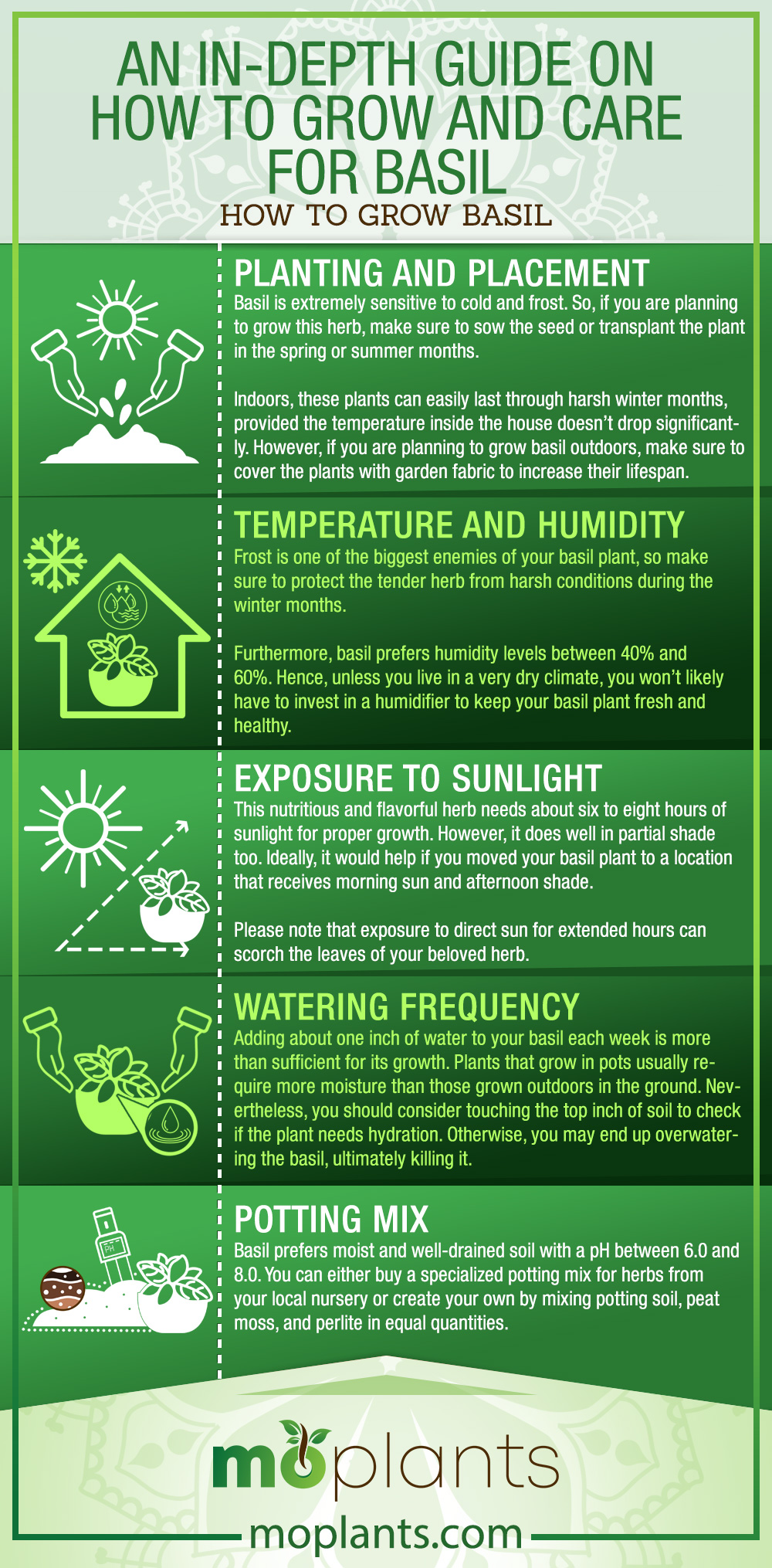
How to Grow Basil from Seeds
Though many prefer transplanting this herb to their kitchen garden, you can also use basil seeds to expand your collection.
The first step to growing basil from seeds is creating starter pots. For this, you will have to add a moist seed starter mix to the potting medium and then add a few basil seeds to each container. Make sure to choose small pots so the seeds can germinate quickly. It is also important to add more than a couple of seeds to every pot, as only a few will germinate.
Once you have added the seeds to the soil, cover them with a dry seed starter mix and gently spray the potting medium with plain water. Move the container to a warm and humid location in your home and wait for the seedlings to emerge.
It usually takes about seven to ten days for the basil seeds to show any signs of growth, after which you can move the pot to a sunny area and keep the soil moist. Once true leaves appear, you can select the strongest seedlings and pinch back those with weak growth.
As soon the baby basil plant develops three pairs of leaves, consider transplanting it to a slightly larger pot and add a weak fertilizer for extra nutrition.
Basil Care Tips
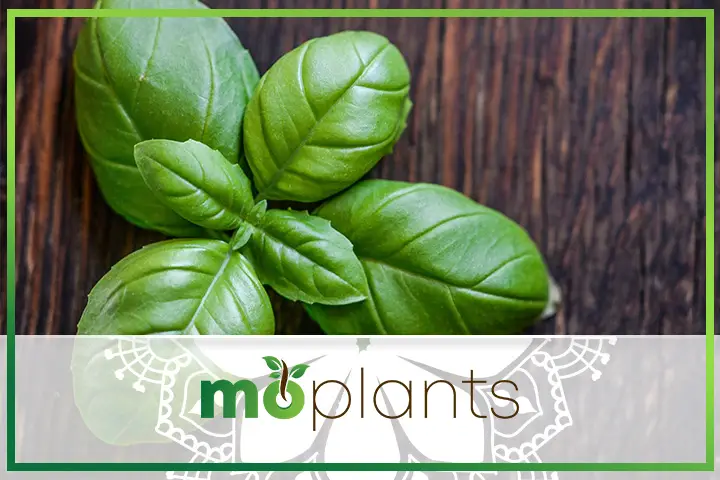
These are some basic care tips that will ensure your plant looks shiny and captivating at all times.
Pruning
Young basil plants have one central stem, which can be pinched back by half an inch above the leaf nodes once the plant becomes six to eight inches tall. This practice will encourage new growth and result in a bushy appearance.
As the plant grows, make sure to pinch back the new branching stems for healthier foliage.
Fertilizing
Frequent fertilization can ruin the flavor profile of your basil plant. However, if you are growing this herb in your backyard, you can feed it liquid fertilizer twice during the growing season. Applying weak liquid fertilizer every four weeks for plants growing indoors is more than enough to keep them thriving.
Spacing
It is ideal to space basil plants approximately 12 to 16 inches apart instead of grouping them all together. Since these herbs are usually as wide as tall, giving each plant its separate container would be best to space them out.
Companion Planting
Want to spruce up your kitchen garden? Consider planting basil next to lettuce, oregano, peppers, and chamomile. All of these plants require similar growing conditions, making them excellent options for companion planting.
In addition, you can also grow basil alongside tomatoes and parsley.
Infographic
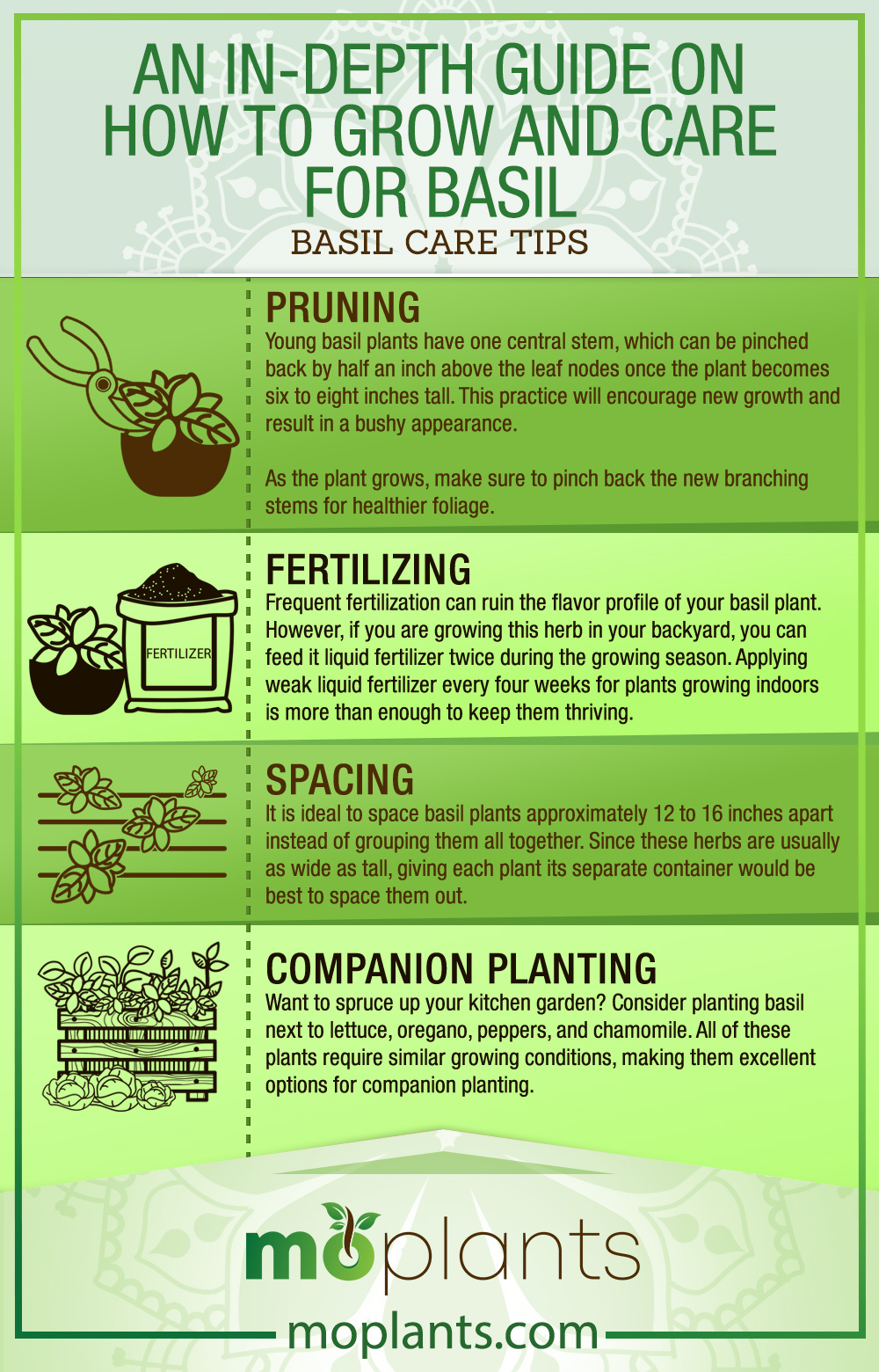
How to Harvest Basil
Most experts recommend picking the leaves of basil only after the plant becomes eight feet tall.
The ideal temperature for harvesting the basil leaves is 80 degrees Fahrenheit and the best time to do so is in the morning. Regularly picking the leaves will encourage new growth throughout the spring and summer months, allowing the plant to stay healthy. It is also a noteworthy basil care tip that all home gardeners should know about.
You can also dry and free these leaves for later use or whip up some pesto for your evening snack.
Common Basil Plant Problems and How to Solve Them
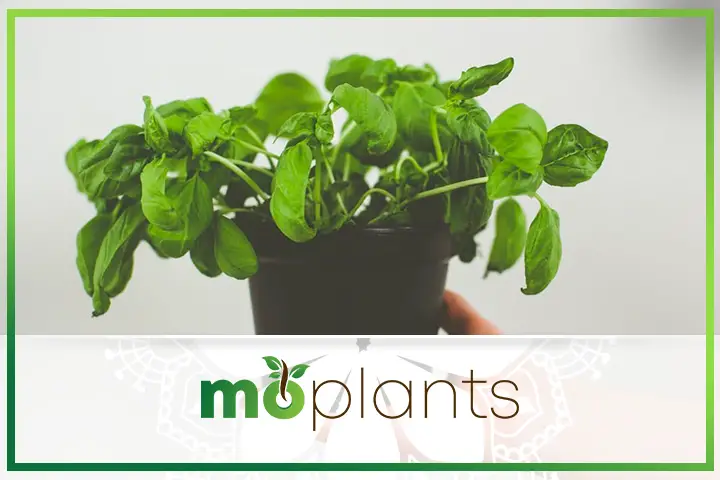
Here are some of the most common issues you may face while growing basil plants in your home. To help you out, we have also presented some solutions that can help you tackle these problems head-on.
Fusarium Wilt
When it comes to basil, there is probably nothing quite as deadly as Fusarium wilt. It is a fungal infection that particularly attacks sweet basil plants, though other varieties are also vulnerable. Moreover, there is no known remedy for this disease.
Some of the most common symptoms of Fusarium wilt include wilting leaves, stunted growth, stem with brown spots, twisted branches, and shedding.
If you notice your plant exhibiting these symptoms, please make sure to destroy it as quickly as possible. It is also suggested to dispose of the potting mix. If the plant was growing in the soil, don’t plant basil or other types of mint plants in that area for at least the next two years.
Discolored Leaves
Lack of light is the most common reason basil leaves begin to lose their color. So, if you think the plant looks pale or light green, please move it to a location that receives full sun for at least six hours a day. Hopefully, your plant will bounce back within a few short days.
Leaves Turning Yellow
If the leaves of your herb are turning yellow, it could indicate that you are overwatering the plant.
Although the herb enjoys moist soil, you should not water it until the top layer of the potting medium has completely dried off.
Leaves Turning Brown
Alternatively, if the leaves of your basil plant are turning brown, it most likely means your plant needs more water.
Common Pests and Diseases
Basil is susceptible to aphids, beetles, and slugs. The best way to troubleshoot this problem is by washing the plant with dishwashing liquid and water. Meanwhile, if you don’t want to use inorganic products to treat your plant, you can wipe the leaves and stem of basil with horticulture oil.
Popular Types of Basil
Each basil variety has a distinctive flavor and appearance. Here are some of the most common types you can grow in your home.
Lemon Basil
This hybrid variety of basil is native to South Asia and Northeastern Africa. It has a rich lemon scent and can grow as tall as 20 centimeters. You add it to your tea, seafood, and vegetables for a wonderful taste.
Thai Sweet Basil
It is one of the most popular types of basil with purple stems and flowers. However, its leaves are rich green and taste spicier than most other varieties. All parts of this aromatic plant are edible. You can use Thai sweet basil in your stir fry for a subtle yet delightful flavor.
Purple Basil
An absolute showstopper, this variety of basil is known for its deep purple and burgundy hues. Due to its clove-like taste, most people prefer steeping these leaves in vinegar or using them as a garnish to add a visual element to prepared dishes.
Cinnamon Basil
This type of basil is also known as Mexican spice basil. Its dark green foliage and lavender flowers give it an almost ornamental appearance. It has a spicy aroma, while its taste reminds one of cinnamon and mint. Additionally, these plants can grow up to 18 inches tall.
Basil Plant FAQs
Let’s answer some of the most frequently asked questions about basil plants.
Can a basil plant survive indoors?
Yes, a basil plant can grow indoors and outdoors as long as you provide it with the right growing conditions.
How long does basil live?
A basil plant may live up to two years or longer in warm climates.
Should I let basil flower?
If you are cultivating the plant to harvest its leaves, it is ideal for removing the flowers as they may affect the taste of the herb.
To conclude, basil is one of the best herbs to grow indoors. It has vibrant foliage and a fragrant scent that can keep away mosquitoes from your kitchen while filling the air with a rich aroma. This plant also boasts tremendous health benefits and can help you up your cooking game.
So, what are you waiting for? Plant some basil in your kitchen garden today!

